Vol 3 No. 37 TROPIC LIGHTNING NEWS September 9, 1968
Index
ENEMY ATTACKS SMASHED
900 VC KILLED IN WEEK
On Sunday, August 18, the enemy came out of hiding to launch a
series of attacks on 25th Infantry Division and Vietnamese forces in Tay Ninh
Province. He hit an impenetrable wall of fire power - the Tropic Lightning
Division.
The enemy was unable to take any of his apparent objectives.
His losses were staggering: more than 900 enemy were killed by the 25th in seven
days following the first clash. Certainly his plans - whatever they may
have been - were foiled.
The 25th knew he was coming; the question was when. Infantry
and artillery units had been deployed astride key avenues of approach to Tay
Ninh City.
When the enemy struck, the 25th was ready. Determined
infantrymen, cannoneers and tankers stopped the enemy’s main thrust into Tay
Ninh City and then set to finding and destroying the VC and NVA as they tried to
move through the rice paddies and rubber plantations around Tay Ninh City and
Dau Tieng.
The fierce fighting began around Tay Ninh City. Late Saturday
night, two companies from the 2d Battalion, 27th Infantry, set up an ambush
along Highway 13 leading into Tay Ninh City from the northwest. The ambush
was sprung on the rear element of an estimated 300 NVA as they moved down the
road. Five enemy were killed in the short engagement.
About four hours later, the 1st Brigade’s base camp to the west
of Tay Ninh City received mortars and rockets. The attack was apparently a
diversion for simultaneous attacks on two 25th Division fire support bases, a
mountain top signal facility, and a special forces camp.
See related pictures and stories on pages 4, 5, 6, 7, and 8.
Fire Support Base Buell four miles north of
Tay Ninh City at approximately 1:30 a.m. Sunday started receiving mortar and
rocket fire. Under cover of the barrage, the enemy launched a ground
attack. Infantrymen and artillerymen fought for three hours; and when it
was over, 83 enemy had been killed.
At the same time, the Viet Cong and North Vietnamese attacked a
U.S. Special Forces and Vietnamese Combined Civilian Defense Group camp at Katum
in War Zone C. There, the enemy’s cost was 59 killed.
The signal facility atop 3,200 foot Nui Ba Den mountain also came
under ground and mortar attack. Ten VC were killed as the Americans
repulsed the enemy.
Sunday morning, an unknown sized enemy force was reported in Tay
Ninh City. They had set several fires in civilian areas of the city.
The Tropic Lightning Division deployed forces in blocking positions around the
city and astride key exfiltration routes as Vietnamese forces moved through the
city flushing out the enemy.
(Continued on Back Page)
Ambush Patrol Fights Back, Slays 56 in Fierce Battle
|
||||
|
25TH DIVISION BATTLE ACTION NEAR TAY NINH AND DAU TIENG. |
2D BDE - An ambush patrol of the 2d Battalion, 27th Infantry,
supported by gunships and artillery, killed 56 Viet Cong in a vicious fight one
mile northwest of the 25th Infantry Division’s base camp at Tay Ninh. At
one point the beleaguered soldiers of Company A burned their clothes and boots
to signal helicopter gunships.
The enemy dead were found the next morning, some as close as five
meters from the U.S. position.
“Everything went all right until about 1:30 when one of our
machine gun positions spotted six VC,” explained Sergeant Paul R. Lambers, 26,
of Holland, Mich.
They fired on what they thought were only six VC and from that
moment on the fighting was hot and heavy.
“Within about 30 seconds after our initial burst we started
receiving heavy automatic weapons fire and also very heavy RPG fire . . . the
RPG’s were coming in at the rate of 6 of 10 a minute,” Lambers said.
The Tropic Lightning soldiers responded quickly to the enemy
assault and returned a withering volume of fire. At one stage of the
battle it seemed as if they would over-run the tiny perimeter, but they were
repulsed.
“There were two rows of VC approximately 30 meters apart.
We could see them coming at us in a horseshoe formation that covered three
fourths of our perimeter,” recalled Private First Class Roger P. Rost, a
radio-telephone operator from Calument, Mich.
During the enemy assaults a machine gun position was hit with a
hand grenade wounding the patrol leader and Lambers assumed command.
Hearing the helicopter gunships circling overhead but not firing,
Lambers was puzzled. Locating a radio, he learned that the infantrymen had
to mark their positions before the gunships could safely engage the enemy.
The task of marking the friendly position was given to Specialist 4
Kenneth M. Cobb, from Tulsa, Okla.
“The only way we had to mark our location was with fire,” Cobb
said. “But it was a little bit hard running around looking for fire
wood. We burned everything we had, our clothes, boots, everything.”
During the battle, gunships, artillery, and an AC-47 Dragonship
assisted the besieged infantrymen.
The Wolfhounds also captured 18 AK-50’s, 3 AK-47’s, 5 light
machine guns, 2 RPG launchers, and 11 drums of ammunition.
Page 2 TROPIC LIGHTNING NEWS September 9, 1968
Decorated
| ARMY COMMENDATION MEDAL FOR HEROISM | |
|
CPT Gary L. Nies, HHB, 1st Bn, 8th Arty CPT Michael A. Mitchell, Co B, 2nd Bn, 22nd Inf CPT David M. Wahlbom, A Btry, 1st Bn, 8th Arty 1LT Eugene Forster, A Btry, 1st Bn, 8th Arty 2LT Raymond C. Robinson, Jr., Co A, 2d Bn, 27th Inf 2LT William T. Orendorff, Co C, 4th Bn, 9th Inf SFC George J. Fedun Jr., HHC, 2nd Bde SFC Albert J. White, Co A, 4th Bn, 9th Inf SSG Richard W. Beedle, HHB, 2nd Bn, 77th Arty SSG Chester L. Eastep, Co A, 4th Bn, 9th Inf SSG Adam M. Flores, C Btry, 7th Bn, 11th Arty SSG Michael, Jenkins, A Btry, 1st Bn, 8th Arty SGT Robert R. Bache, Co A, 1st Bn, 5th Inf SGT Frank T. Goins, Co A, 1st Bn, 5th Inf SGT Earl L. Hughes, B Btry, 7th Bn, 11th Arty SGT Ralph G. Venie Jr., Co A, 1st Bn, 27th Inf SGT Edward Q. Bell II, C Trp, 3d Sqdn, 4th Cav SGT Daniel W. Quinlan, Co C, 1st Bn, 27th Inf SP5 Edward T. Lyons, Co B, 25th Avn Bn SP5 John E. Deardeuff, B Trp, 3d Sqdn, 4th Cav SP5 Wulde W. Schiurring, A Trp, 3d Sgdn, 4th Cav SP5 Jerry F. Ayers, HHB, 2nd Bn, 77th Arty CPL Valen W. Stein, B Btry, 1st Bn, 8th Arty SP5 Leonard B. Holt, Jr., HHB, 2d Bn, 77th Arty SP4 James A. Hall III, Co A, 1st Bn, 27th Inf SP4 Charles D. Magnuson, B Trp, 3d Sgdn, 4th Cav SP4 Harold C. Wright, B Trp, 3d Sgdn, 4th Cav SP4 John Bizer, B Trp, 3d Sgdn, 4th Cav SP4 Robert F. Brescia, Co B, 25th Avn Bn SP4 Kenneth F. Becker, Co A, 1st Bn, 5th Inf SP4 Moy Ming N., B Trp, 3d Sgdn, 4th Cav SP4 Kenneth W. Mardesty, B Trp, 3d Sqdn, 4th Cav SP4 Terry E. Bess, Co B, 4th Bn, 9th Inf SP4 John A. Sullivan, Co B, 3d Bn, 22d Inf SP4 Gary B. Winroth, Co B, 4th Bn, 9th Inf SP4 Ronald J. Sitarski, Co B, 4th Bn, 9th Inf SP4 Theo Gruffin, Co B, 3d Bn, 22d Inf SP4 Steven Macdonald, Co B, 3d Bn, 22d Inf SP4 Larry E. Funderburg, Co, B, 3d Bn, 22d Inf SP4 Jerry Green, Co B, 3d Bn, 22d Inf SP4 Robert E. Smith, Co B, 3d Bn, 22d Inf SP4 Ronald T. Theel, Co B, 3d Bn, 22d Inf SP4 Richard D. Pendell, HHT, 3d Sgdn, 4th Cav SP4 Alfredo Dungca, Co D, 2d Bn, 14th Inf SP4 Joachim Halualani, Co D, 2d Bn, 14th Inf SP4 Robert E. Glennon, Co D, 2d Bn, 14th Inf |
SP4 Terry Wagner, Co D, 2d Bn, 14th Inf SP4 Andre Fontenelle, Co B, 3d Sgdn, 4th Cav SP4 Leroy King, Co B, 3d Bn, 22d Inf SP4 Donnie R. Chadrick, Co B, 3d Bn, 22d Inf SP4 Joseph Pusateri, Co D, 2d Bn, 14th Inf SP4 Allan L. Yenney, Co D, 2d Bn, 14th Inf SP4 David G. Snyder, Co B, 3d En, 22d Inf SP4 Robert L. Fischer, HHT, 3d Sqdn, 4th Cav SP4 Stephen C. Pierce, HHT, 3d Sqdn, 4th Cav SP4 Robert L. Shead, Co B, 3d Bn, 22d Inf SP4 Robert Rossow, HHC, 2d Bn, 22d Inf SP4 William G. Thompson, 25th MP Co SP4 Richard A. John, C Trp, 3d Sqdn, 4th Cav SP4 Lee E. Staton, Co C, 1st Bn, 27th Inf SP4 David L. Kemp, HHB, 2d Bn, 77th Arty SP4 Delbert R.-Roberts, Co A, 2d Bn, 22d Inf SP4 Michael W. Ring, HHB, 2d Bn, 77th Arty SP4 Richard E. Bigham, Co F, 50th Inf SP4 William H. Bonner, Co F, 50th Inf SP4 Frank K. Dasher, Co F, 50th Inf SP4 Francis M. Esposito, Co F, 50th Inf SP4 Stephen R. Gallo, Co F, 50th Inf SP4 Peter J. Husting Co F, 50th Inf SP4 Kenneth R. Olowin, Co F, 50th Inf SP4 Lewis L. Norton, Co F, 50th Inf SP4 Norvell D. Daniels, C Trp, 3d Sqdn, 4th Cav SP4 Albert J. Porter, C Trp, 3d Sgdn, 4th Cav SP4 Carlos Alverio, Co D, 2d Bn, 14th Inf SP4 Andy J. Booth, HHC, 2d Bn, 14th Inf SP4 Eddie M. Bowman, HHC, 2d Bn, 14th Inf SP4 Frederick L. Bracy, Co D, 2d Bn, 14th Inf SP4 Ronnie E. Cavins, Co D, 2d Bn, 14th Inf SP4 Ronnie Cichowski, HHC, 2d Bn, 14th Inf SP4 Dennis L. Ehnes, Co D, 2d Bn, 14th Inf PFC John P. MacQuillim, C Btry, 3d Bn, 13th Arty PFC Kenneth D. Wlodarczyk, Co C, 1st Bn, 27th Inf PFC David J. Dunn, Co C, 1st Bn, 27th Inf PFC Arthur L. Cook, Co B, 3d Bn, 22d Inf PFC David W. Bailey, Co B, 3d Bn, 22d Inf PFC Robert Best, Co B, 3d Bn, 22d Inf PFC Preston L. Johnson, Co D, 2d Bn, 14th Inf PFC Roger D. Whaley, Co B, 3d Bn, 22d Inf PFC Michael Wilhelm, Co B, 3d Bn, 22d Inf PFC Eliseo Cuellar, Co B, 3d Bn, 22d Inf PFC Tommy P. McKamey, Co B, 3d Bn, 22d Inf PFC Carl R. Duncan, 25th MP Co |
Senior NCO Promotions Centrally Handled By ‘69
Department of Army will begin centrally promoting noncommissioned
officers to grades E-8 and E-9 in 1969. The new procedure will roughly
parallel the system currently used to promote officers to field grades, and will
insure an equitable and uniform procedure for promotion on an Army-wide basis.
The system will eliminate the requirement for a position vacancy to
exist in the NCO’s current unit of assignment as a prerequisite for promotion
and will insure that the best qualified NCO’s are advanced to grades E-8 and
E-9.
Soldiers in pay grade E-8 who had promotion list status on 31 July
1968 will be considered by the first DA promotion board for E-9. Those in
pay grade E-7 having promotion list status on 30 September will comprise those
initially considered by the promotion board.
For the initial two zones, commanders who maintain promotion lists
to the grades of E-8 and E-9 have been directed to forward through channels to
DA the names of individuals in their commands who have promotion list status,
together with the following items:
A new Enlisted Efficiency Report.
A copy of the individual’s Form 20.
Copies of letters of commendation and appreciation.
Special recommendations for promotion, if appropriate.
Copies of other items in the individual’s 201 file that would
have a bearing on his selection for promotion to include the Enlisted Efficiency
Report that formed the basis for current promotion list status.
A completed Personnel Data Sheet (Figure 7-3, Chapter 7, AR
600-200).
After all the names are received from commanders, DA will publish a
circular listing all the individuals who are to be considered for promotion.
The promotion board for E-9 will meet in October and the board for E-8, in
December.
About January 1, 1969, another circular will be published
announcing the NCO’s selected for promotion to E-9 during the following six
months. The list of E-8 promotions will appear about 1 March.
In the interim period, commanders will be authorized to promote
from existing lists to fill vacancies, provided a promotion allocation is
received. Commanders are not permitted to add to promotion lists for
grades E-8 and E-9 after the cut-off dates, except that newly assigned NCO’s
who had promotion list status in their old units will be integrated into the
list of their new unit.
Commanders must notify Department of the Army when a man is
promoted so that his name can be removed from the list of NCO’s being
considered by the DA board. Once promotions to E-8 and E-9 begin to be
made from the published lists, local promotion lists will no longer be
maintained for these grades.
Those considered by the DA board and are not selected, will not
retain their previous promotion list status. However, they will be
considered by future boards along with all others competing for promotion.
Subsequent boards will be convened as required and consideration for promotion
will be based upon the criteria of AR 600-200, such as time in grade and time in
service.
Red Cross H&W Plan Eases Family Worries
Normal communications between servicemen and their families are
essential to the maintenance of strong family ties during periods of separation.
When a serious breakdown in family communications occurs, or when
normal communications are not adequate to meet the needs of a particular case,
the Red Cross Field Director will obtain a Health and Welfare Report in an
effort to alleviate a serviceman’s anxiety and to restore normal family
communications.
A Red Cross Field Director realizes that when families are
separated, communications sometimes break down. This results in
misunderstandings and added complications in the problems of daily living.
In the military, a serviceman’s efficiency is often seriously
impaired by lack of communication with his family. Red Cross case
histories contain numerous instances of family tragedies due to the failure of a
serviceman or his family to take the time to write.
So, if you have loved ones, prove it to them and to yourself by
writing frequently and unselfishly. If your family neglects to write to
you, don’t stop writing to them. This will only make the situation
worse.
Red Cross realizes that letter-writing is a difficult task for
many. Remember, even inexpensive postcards can go a long way to preserve
and strengthen family ties - if sent frequently.
Tell your family about some of your pleasant experiences from daily
or weekend life. Tell them about movies you have seen or books you have
read or are reading. Write about the life and culture of the country in
which you are stationed.
Use the library if you’re not informed. Assure your family
that you’re being well taken care of by the military. Above all assure
them of your good health and of your love and affection. Do not magnify
your personal problems and cause your family unnecessary worry.
If you go on TDY or special duty away from your unit for extended
periods of time, or if you transfer to a new unit, be sure to notify your
family. Be sure to fill out postal locator cards with your old and new
units.
If you are not able to establish contact with your family, or if
you’re unable to obtain needed information directly, the Red Cross Field
Director will help you.
For further information, please contact the Field Office of the
American Red Cross.
Contract Provides Choppers
The U.S. Army Aviation Materiel Command awarded a $60 million plus
contract to Bell Aerospace Corp. for the production of 900 UH-1H Iroquois
helicopters commonly called “Hueys.”
Work will be done at Hurst, Texas on the $60,767,550 fixed-price
letter contract, which calls for the delivery of the aircraft in 1970.
In a separate order, the corporation was awarded a $1,700,385
contract for rotary wing blades for the UH-1. Bell Helicopter Co., a subsidary
of Bell Aerospace Corp., also received a $2,076,740 contract to supply the Army
with tail boom assemblies for the UH-1 helicopters. (ANF)
The TROPIC LIGHTNING NEWS is an authorized publication of the 25th
Infantry Division. It is published weekly for all division units in the Republic of
Vietnam by the Information Office, 25th Infantry Division, APO San Francisco
96225. Army News Features, Army Photo Features, Armed Forces Press Service and Armed
Forces News Bureau material are used. Views and opinions expressed are not necessarily
those of the Department of the Army. Printed in Tokyo, Japan, by Pacific Stars and
Stripes.
MG Ellis W. Williamson . . . . Commanding General
MAJ Andrew J. Sullivan . . . Information Officer
2LT Don A. Eriksson . . . . . . Officer-in-Charge
SP4 Bill Berger . . . . . . . . . . . Editor
SP5 Terry Richard . . . . . . . . Editorial Assistant
Page 3 TROPIC LIGHTNING NEWS September 9, 1968
Triple Deuce Factory Trained, Streetfighting Style
Perfected
3D BDE - Intensive training for house-to-house fighting within an
urban area is being conducted by men of the 2d Battalion (Mechanized), 22d
Infantry.
The 3d Brigade infantrymen are determined to be thoroughly schooled
in the arts of urban infighting in the event that the Viet Cong and North
Vietnamese attempt a replay of their abortive Tet offensive.
The scene of the training is a bombed out portion of the Vinatexco
factory, a huge textile plant on the outskirts of Saigon above Tan Son Nhut air
base. Daily classes on the problems and techniques of urban fighting are
staged for the men of the Triple Deuce.
The training includes lessons in how to clear buildings of the
enemy, how to employ special weapons with the battalion’s integral armored
personnel carriers, and study of enemy urban tactics. The infantrymen also
are taught how to supervise the evacuation of civilian refugees from the combat
zone.
For the men of the battalion, the problems of urban fighting
present a radical change from the desolate jungle and rubber plantations near
their home base at Dau Tieng in War Zone C.
In the blackened Vinatexco factory, which served as an enemy
stronghold during the Tet fighting, the infantrymen are able to operate in the
partially destroyed buildings just as they would in actual urban fighting.
They use grappling hooks and other special gear, much of which was fabricated by
the battalion’s maintenance section.
“If the time ever comes that my men must fight in the city, they
will be trained and ready,” said Lieutenant Colonel King J. Coffman, Bn. Co.
“They will know what has to be done, and will do it well.”
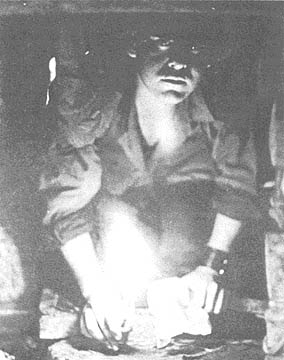 |
CANDLE POWER - Before blowing a Viet Cong bunker found five miles east of Cu Chi, Private First Class Robert Maciag of Detroit, Mich., inspects it using a candle he discovered in the bunker. Maciag, a combat engineer from the 65th Engineer Battalion, is attached to Company A, 2d Battalion, 14th Infantry. (PHOTO BY PFC TOM QUINN) |
Dragons Net Rockets And Two Enemy
1ST BDE - A Hoi Chanh’s help paid off as a rifle company captured
forty-one 107 millimeter rockets cached by Viet Cong in a village 10 miles south
of Cu Chi.
Company C, 2d Battalion, 14th Infantry was helilifted in after
intelligence sources indicated a sizable cache of rockets was in the vicinity.
Accompanying the Golden Dragons was an intelligence officer and a Hoi Chanh with
knowledge of Viet Cong activities in the area.
Company C moved into the village, and the Hoi Chanh immediately
pointed out two suspected Viet Cong. When interrogated, one of the
suspects gave the location of several rockets.
“We went to the location; and sure enough, there they were,”
said Private First Class Gary Shannon of Newville, Pa.
The men quickly formed a human chain and passed 17 rockets to a
dike where a helicopter landed and extracted them to Cu Chi base camp. The
other suspect led the Tropic Lightning troopers to another site where probing by
the Dragons in five feet of water revealed a larger find of 24 rockets.
Close by, mine sweeping teams discovered 18 claymore mines and 300
pounds of TNT.
Search Of Enemy Body Uncovers Lost Wallet
1ST BDE - “It’s amazing -I never thought I’d see them
again,” remarked Sergeant Rex D. Cobb of Des Arc, Ark., when his personal
papers and photographs were returned to him.
They had been found on the body of a Viet Cong by a Vietnamese
soldier from the ARVN 5th Infantry Division. A month before and nine miles
from where the VC was killed, Cobb’s wallet had been stolen.
Cobb had returned to the 4th Battalion, 9th Infantry, forward base
following a tiring night ambush patrol nine miles northwest of Saigon. The
soldier laid his wet clothing and wallet on a rice paddy dike to dry out and
then tried to get some sleep.
During the morning, a water buffalo from a nearby village strayed
into the camp, and several villagers were allowed in the area to retrieve it.
One of them was believed to have stolen Cobb’s wallet.
One month later and nine miles to the north, elements of the ARVN
1st Battalion, 9th Infantry, made contact with a company from the Viet Cong
Go-Mon battalion. Following the fight, an ARVN soldier was searching the
four VC killed when he found Cobb’s papers. Through the U.S. advisor to
the unit, he returned them to Cobb.
According to Cobb, $25 and the wallet itself were missing, but all
his identification cards, personal and photos were intact. “I’d
replaced everything but the photos,” said Cobb, “I’m sure glad to get them
back.”
Ambush Works Twice On VC
2D BDE - Wolfhounds from the 2d Battalion, 27th Infantry sprang
their ambush twice only 30 minutes after setting up.
Platoon Sergeant Stephen Hanson of Upland, Calif., said: “We got
a call from our company’s night location saying that one of the listening
posts had spotted 20 VC 100 meters from them and coming our way.”
“We really opened the ambush up twice,” reported Sergeant
Roosevelt Quinney, a squad leader for the 2d Platoon of Company D. “One
of the NVA soldiers started to pick up a claymore which forced us to spring the
ambush early. The second time was when the enemy reformed and made an
attempt to get their dead and wounded,” the Louisville, Ky., soldier
continued.
Specialist 4 Larry Kern from Folkston, Ga., a machine gunner,
triggered the initial ambush. “After I detonated my claymore I went to
my machine gun. I used up 900 rounds,” he said.
The following morning two dead NVA soldiers were found. The
Wolfhounds used scout dogs from the combat tracker teams in an extensive search
of the area and turned up one AK-50 assault rifle, two NVA explorer helmets, one
NVA gas mask, two ammo pouches and three 30-round clips for an AK-50.
Truck Riding Watermen Keeps The Taps Topped
CU CHI - If you consumed 10 gallons of water a day every day, it
would take you more than 10 years to use the quantity of water delivered in a
24-hour period by the water squad of Company B, 25th Supply & Transportation (S & T)
Battalion.
According to Captain John R. Moran of Beverly, Mass., “Water is
supplied to any unit on the Cu Chi base camp that does not have organic
water-hauling capabilities. This includes the Replacement Center, Military
Police Company, and the PX snack bar.” In all, there are 54 activities
that get water from S & T.
“To accomplish this we employ two 5,000-gallon tankers and make
deliveries around the clock,” stated Staff Sergeant John Person, NCOIC of the
water delivery squad.
“We also have a 1,200 gallon truck that we use in places where
the big trucks cannot maneuver,” added Person, of Trenton, N.J.
Bobcat Gets Hung Up On Wire,
Untripped Trap Fails To Blow
2D BDE - People get “hung up” on a lot of things, but a booby
trap trip wire is perhaps one of the worst.
Sergeant Odell Posley, 21, of Hodges, S.C., had such a hang up
while on a reconnaissance-in-force mission in the Michelin Rubber Plantation
near Dau Tieng.
The 1st Battalion (Mechanized), 5th Infantry had been in sporadic
contact with snipers and mortared several times the three days before. Ordnance
experts of the 65th Engineer Battalion attached to the Bobcats had been blowing
bunkers and booby traps as they progressed through the dense, uneven terrain of
the plantation.
Walking point on the right flank, Posley suddenly yelled, “Booby
trap! Everyone get back!” Sergeant Terance Brady of Denver, Colo.,
carefully moved toward Posley’s position.
“Posley was just standing there like a statue with his hands out
to his sides,” said Brady. “I asked him if he could see what it was
and he said, “don’t come any closer I’m hung up on it!”
The taut trip wire had caught on the lower right hand pocket of his
fatigue shirt. “I knew I couldn’t stand there all day,” Posley said,
“so I very gently - and I mean very gently - picked the trip wire off my
button, expecting it to blow any second.”
Throwing himself as far away as he could, and covering his head as
he hit the ground, Posley waited for the explosion, but nothing happened.
Further investigation turned up a grenade with a half-pulled pin, and the
engineers blew it in place.
Taking an offered cigarette with shaking hands, Pos1ey said:
“Man, I just aged ten years.”
| “GET BACK! I’M HUNG UP!” - Sergeant Odell Posley of Hodges, S.C., motions for the others to keep away as he suddenly discovers an almost invisible booby trap trip wire caught on his button. | 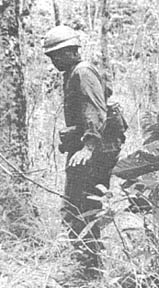 |
Inf. Sweep Catches NVA Mortarmen
2D BDE - Sweeping through the early morning mist of the Michelin
Rubber Plantation four miles northeast of Dau Tieng, the 1st Battalion
(Mechanized), 5th Infantry, got an NVA mortar squad’s day off to a bad start.
Pointman, Sergeant Phillip McFarland of Vidor, Tex., was crossing a
deep gully when he noticed a fish trap in a stream. Before he could cross
to the other side, heavy small arms fire erupted from the dense underbrush to
his front.
Quickly reacting to the commands of Alpha Company commander,
Captain Donald Schiltz of Big Fork, Mont., the men got on line and charged
through the gully laying down a heavy base of fire.
The first to break through the underbrush, McFarland stated,
“Charlie had gone, but his hammocks were still swinging and his chop-chop was
cooking on the fire with gear all over the place.”
Captured were several 60mm mortar fuses, a sight and various other
mortar equipment along with several pounds of documents and propaganda
literature. The Bobcats also found AK-47 ammo, various clothing articles,
web gear and other personal gear and cooking utensils.
Page 4-5 TROPIC LIGHTNING NEWS September 9, 1968
Bobcats Slay 182 In 1 ½ Hour Battle
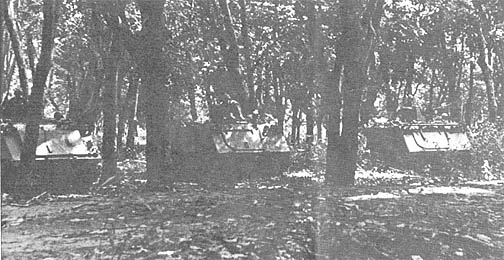 |
|
Bobcat APC’S advance on line through the Ben Cui Rubber Plantation |
2D BDE - When the smoke lifted, the 25th
Infantry Division’s 1st Battalion (Mechanized), 5th Infantry, counted 182
enemy killed in the fierce battle two miles southwest of Dau Tieng.
The action began shortly before noon and lasted only 1½
hours as an unknown size force of Viet Cong and North Vietnamese regulars met
their match in the Ben Cui Rubber Plantation.
The Bobcats, working with the 3d Brigade’s Combined
Reconnaissance-Intelligence Platoon (CRIP), were sweeping through the rubber
plantation when they began receiving small arms, mortar and rocket fire.
Using the on-line tactic the men and their armored personnel
carriers (APCs) moved forward and encountered the enemy head on. The
combined, mech-CRIP force firmly stood their ground as the enemy attempted a
brazen human wave assault.
With crushed determination and heavy losses, the enemy began to
retreat, but the Bobcats pulled out in fire-and-maneuver pursuit burning up
several .50 caliber machine gun barrels in the process.
Dangerously low on ammunition, the Bobcats pulled back as tactical
air strikes, gunships and artillery continued to pound the enemy.
After a short, yet fiercely fought battle, the 25th Division force
returned to Dau Tieng leaving 182 enemy dead.
PHOTOGRAPHS BY
SP4 Don Mousseau
 |
AN INFANTRYMAN LAYS DOWN A FIELD OF FIRE WHILE HIS BUDDY CHARGES. |
| REACHING HANDS STEADY A LITTER TO AID A WOUNDED BUDDY. | 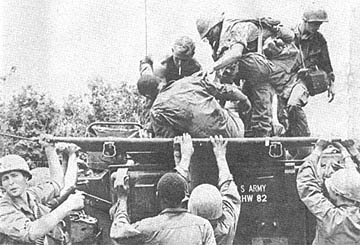 |
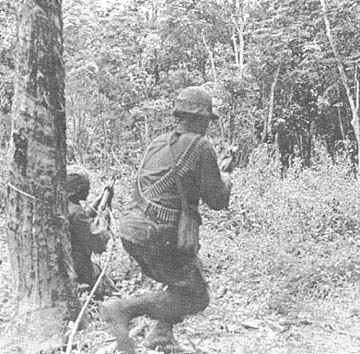 |
A CHARGING SOLDIER GIVES FIRE SUPPORT TO A GRENADIER. |
| A DEADLY MACHINEGUN TEAM BLAZES AWAY. | 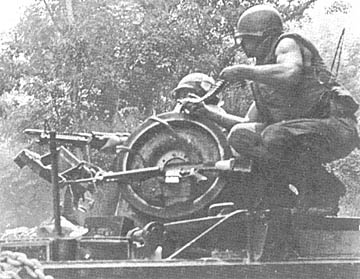 |
 |
POSITIONED TROOPERS DISH OUT A WALL OF HOT LEAD TO CHARGING VC. |
| A GRIMACING CHAPLAIN TURNS TOWARD A CALL FOR HELP. |  |
Page 6 TROPIC LIGHTNING NEWS September 9, 1968
1ST BDE - Infantrymen and artillerymen of the 25th Division fought
valiantly to halt a determined enemy ground attack on Fire Support Base Rawlins,
four miles east of Tay Ninh City. The enemy lost at least 25 killed in
their ill-fated attempt to break through the perimeter.
Having been in contact with the Viet Cong all afternoon Companies A
and B, 4th Battalion (Mechanized), 23d Infantry, withdrew from the area of
contact to secure Rawlins along with elements of the 1st Battalion (Mechanized),
5th Infantry; the 3d Battalion, 13th Artillery; and the 7th Battalion, 11th
Artillery.
Just after midnight the enemy began to pour a heavy volume of 82mm
and 60mm mortars into the fire support base. Within minutes the mortars
were dropping in at a heavier rate and the VC and NVA launched a ground attack.
Specialist 4 Loni Ramey of Massillion, Ohio recalled: “They came
charging at us firing RPG-2’s and 7’s like they were M-16’s. There
just wasn’t a hole deep enough to hide and fight from.”
The Tomahawks countered with barking .50 caliber machine guns
putting down a devastating hail of fire. “I saw four of them crawling
toward the wire,” reported Private First Class James A. Brown of Ashland,
Ill., “So I dropped a few M-79 rounds out there. There was no more
movement from that area for the rest of the firefight.”
Captain William R. Houston of St. Petersburg, Fla., who was
responsible for the security of Rawlins requested gunships from the 3d Squadron,
17th Air Cavalry. With the Tomahawk mortar sections and supporting
artillery illuminating the U.S. position, gunships rained a hail of tracers on
the exposed enemy in the rice paddies in front of one sector of the perimeter.
Since the gunship fire was not effective on the enemy attacking
from a rubber plantation, Houston directed the artillery pieces in the perimeter
to fire short-fuzed artillery rounds on the enemy camouflaged by the rubber.
The gunship team braved enemy .51 caliber machine gun fire as they
supported the infantrymen but had soon expended almost all of their ammunition
and had to return to Tay Ninh Base Camp to rearm. Specialist 4 Larry
Sutherland of Rushville, Ind., recalled: “When the gunships left, the crack of
the AK’s seemed to come closer and closer.”
At this point Houston directed tactical air strikes on the
determined VC and NVA. As the tactical fighters cruised in to support the
Tropic Lightning soldiers, the enemy countered with anti-aircraft fire.
Specialist 4 Wayne D. Finch of Middleport, N.Y., saw the position and pointed it
out to the Tomahawk mortar section. On the next pass the fighters received
no fire - the mortar section had silenced the gun.
Ammunition was getting low, and Houston requested an emergency
resupply. When the helicopter arrived at the scene of battle, the fire was
so intense that it was unable to set down. It hovered over the U.S.
position and cases of ammunition were kicked out to fall freely to the ground.
The fire fight raged on, as the 1st. Brigade soldiers used star
clusters to mark their position for the air strikes which dropped 500-pound
bombs on the weakening enemy. After three air strikes and a withering hail
of fire the enemy force began to break contact and retreat - after five bloody
hours Fire Support Base Rawlins was saved.
 |
MOVING OUT - Company C of the 1st Brigade’s 4th Battalion (Mechanized), 23d Infantry, moves out on their tracks to sweep south of Tay Ninh City looking for fleeing Viet Cong who have just set 220 homes afire in the province capital. (PHOTOS BY SP4 RICK ADAMS) |
Copter Braves Hostile Fire; Completes Ammo Resupply
1ST BDE - A 25th Infantry Division fire support base besieged by a
fierce Viet Cong ground attack was resupplied with ammo at the height of the
battle by a daring helicopter crew.
The helicopter crew from C Troop, 3d Squadron 17th Air Cavalry,
flew through enemy ground fire to kick off 1,000 lbs of ammunition to troops of
the 1st Brigade, holding down Fire Support Base Rawlins III, four miles east of
Tay Ninh City.
Troops at the fire support base were running out of M-60 machine
gun ammunition used on-line to cut down the charging Viet Cong, and called back
to the 1st Brigade headquarters, west of the city, for resupply. Chief
Warrant Officer Tom Holer and his crew loaded their UH-1H helicopter with 1,000
pounds of vital ammunition and headed out to the fighting.
When the chopper got near the base an air strike was pounding enemy
positions around the perimeter of the camp. As the ship waited for the air
strike to lift, they ran low on fuel and had to return to Tay Ninh.
Back flew the chopper, but air strikes still continued to bomb
enemy positions. “It looked like a big war down there,” stated Holer,
22, of Elmhurst, Ill. “The air strike finally ended and then it was our
turn.”
Warrant Officer Earl Warwick, a 20-year-old co-pilot from Princess
Anne, Md., told of the fine support given the ship as it flew into the camp:
“As we flew in from the east to the west, we had gunships covering our flanks
with heavy fire. An AC-47 Spooky aircraft was dropping flares which helped
a lot. The guys down there had put out a white T to mark our drop off
point,” Pilot Holer said, “Just as we were close to where we should have
been they fired a red star cluster which did not blind me and gave just the kind
of light I needed.”
The ship’s two door gunners did not get behind their M-60 machine
guns as they prepared to unload the ammo as the ship flew in. Specialist 5
John Parsons, 21, of Detroit, Mich., and Specialist 4 Jeff Greene, 19, from
Sacramento, Calif., explained what it was like as they hovered 15-feet above the
ground, shoving the ammunition off the ship.
“All I could see was explosions and flashes all around the ship.
Grabbing those boxes of ammo and tossing them off was the fastest thing I’ve
ever done,” related Parsons.
Greene remembered, “There were several men below us and they were
breaking open the boxes as fast as we could unload them.”
At 3:30 a.m., the ship had unloaded all the ammunition and returned
to Tay Ninh. Contact at the base broke off at 5 a.m. The
infantrymen, gunships and air strikes had killed 25 enemy soldiers in the early
morning attack.
| BLOCKING FORCE - Captain Henry Philips, commander of C Company, 4th Battalion, 23d Infantry, directs a tank into position as he sets up blocking positions just outside Tay Ninh City. Philips from Columbus, Ga., and his mech unit blocked exfiltration routes as Vietnamese forces flushed VC from the city. | 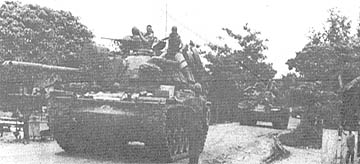 |
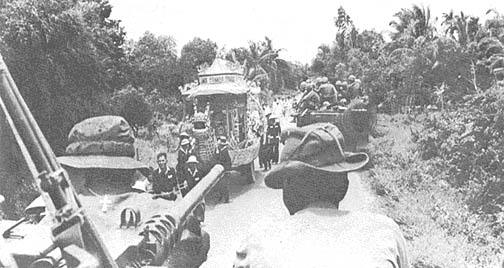 |
| FUNERAL MARCH - While chasing Viet Cong from Tay Ninh City, Company C, 4th Battalion, 23d Infantry, slows down to allow a Vietnamese funeral march to pass by. The 1st Brigade unit gave up its blocking position south of the city to go after Viet Cong fleeing the city. |
Page 7 TROPIC LIGHTNING NEWS September 9, 1968
FSB Buell Repels Two Attacks In Four Days
Bn-Sized Enemy Force Loses 83 During Battle
3D BDE - Tropic Lightning Division infantrymen and artillerymen at
Fire Support Base Buell repelled a human wave attack launched by an
unknown-sized enemy force, killing 83 enemy.
The enemy attempted to storm the perimeter four miles north of Tay
Ninh City after subjecting the defenders to a thundering rocket and mortar
barrage.
Infantrymen and tankers from the 3d Battalion, 22d Infantry; 2d
Battalion, 34th Armor, and 4th Battalion (Mechanized), 23d Infantry, along with
howitzers of the 3d Battalion, 13th Artillery, and the 7th Battalion, 11th
Artillery, supported by helicopter gunships and tactical air strikes drove off
the enemy and captured hundreds of pounds of equipment, weapons and ammunition
during the four-hour night battle.
Lieutenant C.C Brown of Auburn, Ala., of Delta Company, 3d Bn, 22d
Inf, credited trip flares with playing a major part in making the night defense
a success.
“The flares gave us a clear view of the enemy as he attempted to
enter the perimeter.”
A sweep near the perimeter the following morning found 40 freshly
dug foxholes plus tunnels and numerous bunkers. The Tropic Lightning
soldiers policed up ten large piles of enemy ammo, bangalores, grenades,
ammunition and RPG rocket rounds, all of which were destroyed by engineers.
During the sweep, men of Delta Company, 3d Bn, 22d Inf, made
contact with a straggling enemy force. Sergeant Robert Clark of Atlanta,
Ga., and his platoon caught three enemy in an open field and cut them down.
They surprised and killed several more in a bunker.
Included in the items captured were 11 RPG rocket launchers, 112
RPG rounds plus 18 boosters, 15 AK-47 assault rifles, three Chicom machine guns
and a .30 caliber machine gun.
Also captured were 214 Chicom grenades, 21 57mm recoilless rifle
rounds, 40 anti-tank rifle grenades, eight 60mm mortar rounds, 24 bangalore
torpedoes and more than 4,000 rounds of rifle ammunition.
“This was the finest piece of work that’s ever been done by
anyone under my command,” said Lieutenant Colonel Alexander Hunt, the 3d Bn,
22d Inf, Co. “Infantrymen, support troops, gunships – all did an
outstanding job. Not one enemy soldier got inside the perimeter all night
long.”
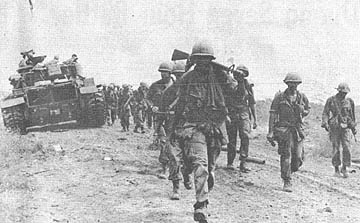 |
MOP UP - Tired Regulars from the 3d Platoon of Company D, 3d Battalion, 22d Infantry, march back to the perimeter of Fire Support Base Buell II. The infantrymen were returning from a sweep of the area to determine the extent of VC-NVA losses in an unsuccessful ground attack on their perimeter. A tank from A Company, 2d Battalion, 34th Armor, provides security. |
VC-NVA Fail Again
U.S. FORCES CRUSH 2D ASSAULT
3D BDE - An unknown sized enemy force launched a second attack in
four days on Fire Support Base Buell four miles north of Tay Ninh City.
The enemy lost 39 in their abortive attempt to penetrate the perimeter.
Elements of the 3d Battalion, 22d Infantry; 4th Battalion
(Mechanized), 23d Infantry; and 2d Battalion, 34th Armor along with cannoneers
from the 7th Battalion, 11th Artillery, and 3d Battalion, 13th Artillery,
repelled the human wave attack.
At 1:00 in the morning 82mm mortars and rockets came whistling into
the perimeter followed by a ground attack that lasted until 5:45 a.m. “The mortars even continued after the ground attack started,” said
Specialist 4 Al Gibbs of Philadelphia, Pa. “That’s what made this
attack harder to handle than the first one.”
Company D and the Reconnaissance Platoon from the 3d Bn, 22d Inf,
were responsible for one side of the perimeter and Company C of the 4th Bn (Mech), 23d
Inf, for the other, with the tanks and artillery providing support.
“Our listening posts spotted movement, and we immediately pulled
them in,” commented Platoon Sergeant Robert Nelson of Hannibal, Mo., from
Delta Company. “They hit two of our platoon sectors hard. Many VC
lay out in the brush firing RPG’s at our bunkers. Others tried to charge
the wire and insert bangalore torpedoes, but we stopped them cold,” said
Nelson.
“The VC marched right up the road that bisects the perimeter,”
said Sergeant Robert Clark of Atlanta, Ga. “We held them off with our
machine guns and M-16’s. Unfortunately our claymores were not too effective.
The VC had shot them full of holes. Some APC’s from 4/23 and one of the
tanks came up quickly to help us. The tank was firing point blank at the
attackers which had the effect of turning a giant claymore mine on them.”
First Lieutenant C.C. Brown, reconnaissance platoon leader from
Auburn, Ala., had his unit deployed as a reaction force behind Delta Company.
“As soon as the attack started we moved right up to help hold the bunker line.
We came up to plug gaps in the line and to help out those positions that were
pinned down.”
Once again artillery and mortars played an important part in making
the defense a success.
“We had 105’s and 155’s firing point blank just
outside the perimeter. These high explosive projectiles showered the enemy
with shrapnel,” said Lieutenant James W. Carper, 3/22 liaison artillery
officer from Tampa, Fla. “We also called for 8 inches from the 1st
Brigade at Tay Ninh and 175’s from Camp St. Barbara,” continued Carper.
Delta’s 81mm mortar crew fired 137 illumination rounds and 235
high explosive rounds during the attack. “The crew. (Privates First
Class Alex Sudano, of Los Angeles; Bob Searfoss, of Summit Hill, Pa.; and Dennis
Bealka, of Chaska, Minn.) put out a maximum effort that helped save the base,”
said Lieutenant John Paulding, New Cumberland, Pa., Delta Company platoon
leader.
A sweep around the perimeter the next morning turned up the 39
enemy.
“Once again the men under my command did an outstanding job.
Once again, not one VC set foot inside the perimeter,” said Lieutenant Colonel
Alexander Hunt, commander of the 3d Bn, 22d Inf.
Major Jerome G. Johnson from Green Bay, Wise., operations officer
for 3/22, praised the efforts put forth by all units in the perimeter: “We couldn’t have done it without them. The tanks, APC’s, and the
artillery were just what our infantry troops needed to help repel the attackers
successfully.”
|
Story and photos |
 |
NEVER USED - A rifleman from the 2d Platoon of Company D, 3d Battalion, 22d Infantry, polices up RPG rounds just outside the wire at Fire Support Base Buell. An enemy force launched a second unsuccessful ground attack on the 1st Brigade base. |
| AFTERMATH - A weary Regular from Company D, 3d Battalion, 22d Infantry, shovels expended M-60 links and brass away from his position at FSB Buell. The huge pile of links and brass is a partial indication of the tremendous fire power put out at his position the previous night. |  |
Page 8 TROPIC LIGHTNING NEWS September 9, 1968
Smash VC Attacks, 900 Killed In Week
(Continued From Page 1)
In the southeastern portion of the city elements of the 4th
Battalion (Mechanized), 23d Infantry, and the 3d Squadron, 4th Cavalry, killed
10 enemy.
Meanwhile, the 1st Battalion (Mechanized), 5th Infantry, was moving
into the Ben Cui rubber plantation 11 miles east of Tay Ninh City near Dau Tieng. They clashed with the enemy at 10:30 a.m. and in six hours of heavy
fighting, killed 50.
After a comparatively quiet night, mechanized forces of the
Division again set out looking for the enemy. They found him.
At 9:30 a.m. Monday, the 3d Squadron, 4th Cavalry, was moving down
Highway 26 when four miles east of Tay Ninh City, they received small arms,
automatic weapons and RPG fire from an unknown-sized enemy force entrenched in
nearby rice paddies. Reinforced by elements of the 1st Battalion
(Mechanized), 5th Infantry, and the 4th Battalion (Mechanized), 23d Infantry,
they fought until 5:45 p.m. killing 40 enemy.
At the same time, elements of the 1st Battalion (Mechanized), 5th
Infantry, again made contact in the Ben Cui Plantation. They were
reinforced by elements of the 3d Squadron, 4th Cavalry, and killed 67 enemy in
the ensuing four-hour battle.
Before dawn Tuesday, several U.S. camps received harassing mortar
fire. But, an ambush patrol from the 2d Battalion, 27th Infantry, met with
more than harassment.
The patrol opened fire on six VC moving to their front and
immediately came under heavy attack from an unknown-sized enemy force. “The RPG’s were coming in at a rate of six to ten a minute,” recalled
Sergeant Paul Lambers of Holland, Mich., who took charge of the patrol when the
patrol leader was wounded. After four hours of intense fighting, the enemy
withdrew. He left 56 bodies on the battlefield.
Except for a mortar attack on Dau Tieng base camp, all was quiet
during the night and until almost noon Wednesday. Then, at 11:30 a.m., the
1st Battalion (Mechanized), 5th Infantry, was again searching out the enemy in
the Ben Cui Plantation when they ran head-long into an unknown-sized enemy
force. Track-mounted .50 caliber machine guns blazed until the barrels
burned out as the enemy launched three human wave assaults at the Tropic
Lightning troops. After 1½ hours of all-out battle, the Bobcats had to
return to Dau Tieng base camp for more ammo, and airstrikes and artillery
continued to pound the enemy during the afternoon. The sharp battle left
182 enemy dead.
At 1:00 a.m. Thursday, the enemy launched a pair of mortar and
ground attacks on two fire support bases. Buell was hit for the second
time in five days. Artillery tubes were lowered to fire point blank and
determined infantrymen spewed hot lead at the attacking force. This time,
the enemy’s abortive attempt to overrun the base cost him 39 lives.
Simultaneously, Fire Support Base Rawlings, two miles east of Tay
Ninh City, was hit by a mortar and ground attack. Here, the infantrymen
and artillerymen took a toll of 25 enemy killed.
At first light Thursday, the 1st Battalion (Mechanized), 5th
Infantry, and the 2d Battalion, 27th Infantry, again swept into the Ben Cui
Plantation. Early in the morning, they met light resistance and killed 10
enemy.
After five days of fierce fighting, Friday was comparatively quiet
for the soldiers. But, the breather was not long-lived.
Just 20 minutes after midnight Saturday morning, the 2d Battalion,
27th Infantry, at Fire Support Base Schofield five miles southwest of Dau Tieng
was attacked by an unknown-sized enemy force. Close-in artillery fire and
gunships supported the infantrymen as they killed 62 enemy.
As fighting tapered off somewhat, the soldiers had time to reflect
on an exhausting but highly successful week. The combined fire power of
infantry, artillery and helicopter gunships along with always-present tactical
jet fighters had dealt the enemy a crushing blow. More than 900 Viet Cong
and NVA soldiers were killed as they tried to dent the Tropic Lightning
Division’s impenetrable wall of fire power.
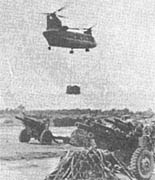 |
PARTNERS - Muleskinners of the 242d Support Helicopter Company move the 1st Battalion, 8th Artillery during action around Tay Ninh. (PHOTO BY SP4 KARL GUTKNECHT) |
Diamondheads Give Support During Seven Hour Battle
CU CHI - More than seven hours of continuous fire support was
provided by Diamondhead gunships from Company B, 25th Aviation Battalion, as a
platoon-sized ambush patrol from the 2d Battalion, 27th Infantry, beat back
enemy attacking from three sides. Firing as close as 15 meters from the
friendly position, the choppers were guided by a fire of burning clothes and
boots.
While performing counter-mortar duties at Dau Tieng Base Camp, the
Diamondhead 20 light fire team was called to assist the besieged infantrymen
near Tay Ninh City. Enroute to the contact area, the fire team leader
Second Lieutenant Neil M. Weems, received the tactical briefing from the ground
commander. The U.S. element was surrounded on three sides with the enemy
no more than 30 meters from the friendly unit’s perimeter.
Arriving at the contact area, a more thorough briefing revealed the
situation to be critical. The Wolfhounds had suffered numerous casualties,
and their ammunition supply was dangerously low. The seriousness of the
situation was magnified by the lack of any means to mark the limits of their
perimeter, which prevented immediate fire support.
The urgency of the mission heightened when the ground commander
reported he had visual contact with numerous enemy as close as 15 meters to his
perimeter and expressed doubt that, due to critical ammunition shortage and
massing enemy troops, he would be able to withstand the imminent ground attack.
As a last resort for position identification, the infantrymen set
fire to a pile of clothes, boots and anything else they could find. With
this one light, aided by artillery illumination, immediate firing passes were
initiated by the Diamondheads. After expending all rocket and minigun
ordnance the situation remained such that the Diamondheads resorted to firing
personal weapons.
Having expended all ordnance aboard and dangerously low on fuel, a
member of the fire team, First Lieutenant Kenneth Griffith, an artillery
officer, adjusted supporting artillery fires enabling an airborne forward
observer to pinpoint the location of the ground unit.
With repeated passes through enemy ground fire, it became apparent
that continuous air support was required. Coordinating with his wing ship,
commanded by Warrant Officer Robert H. Moore, Weems arranged to have one gunship
continue to engage the target while the other aircraft returned to Tay Ninh to
rearm.
The continuous fire support over a seven-hour period was
instrumental in deterring the imminent ground attack long enough to allow
reinforcements to reach the area. Later sweeps of the area revealed that
at least 56 enemy were killed in the fierce battle.
| WELL DONE! - Sergeant Paul Lambers receives congratulations from Major General Ellis W. Williamson, 25th CG. Lambers took command shortly after his platoon leader was wounded and directed his men in a fight that killed 56 enemy. (PHOTO BY SP4 BILL CLEVENGER) |  |
Six-Pronged Attack
Regulars Save Relay Site
3D BDE - Driving off a reinforced Viet Cong company and killing at
least 10 attackers, 25th Division infantrymen staged a heroic defense to save
the retransmission and relay site atop Nui Ba Den mountain.
Plagued by 45 mile-an-hour winds, the defenders, including Alpha
Company, 3d Battalion, 22d Infantry and members of the Provisional Company,
125th Signal Battalion, which operates the communications facility, held their
ground despite near-zero visibility.
The mountain outpost was hit with a six-pronged attack in the midst
of a rainstorm four hours before dawn.
“The VC were running all over the edge of the perimeter,” said
Captain Ardre Blackmon of Augusta, Ga., Alpha Company commander. He said
the enemy used wire cutters to get through the concertina and rubber bands to
render trip flares harmless.
While the 3d Brigade Regulars were holding the bunker line, First
Lieutenant Philip A. Girmus, signal officer from Seattle, Wash., was leading his
reaction force of signalmen from the signal site at the crest of the peak down
to the threatened perimeter.
Shortly after the attack started, Captain Blackmon was faced with a
decision whether to pull his men back to the top of the outpost or to have them
stay and hold the bunker line. He chose to have his men hold, and this was
seen as a major factor in saving the site and in defeating the enemy, probably
saving many lives.
“My men are real heroes,” said Blackmon. “They did what
they were told and they did it well.”
Many individual acts of heroism were cited by infantrymen who
withstood the murderous assault.
Men of the 588th Engineers Battalion put a security force in
position around the signal buildings at the top of the mountain.
Lieutenant Edward D. Montgomery of Burns Flat, Okla., Alpha
Company’s forward observer, kept eight-inch artillery shells raining in on all
avenues of approach.
A sweep around and throughout the perimeter revealed the dead and
numerous blood trails. More than 15 weapons were confiscated, among them
eight RPG rocket launchers, two AK-50 assault rifles and four Chi-Com pistols.
In addition, 30 RPG rounds were found, as well as more than a hundred satchel
charges.
Thanks to
Paul Gargis, 3rd Bn., 22nd Inf. for sharing this issue,
Kirk Ramsey, 2nd Bn., 14th Inf. for creating this page.
This page last modified 8-12-2004
©2004 25th Infantry Division Association. All rights reserved.